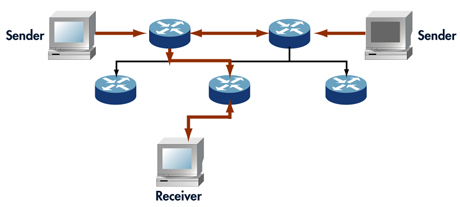Multicast
2008-02-22 12:37:56来源:互联网 阅读 ()

Contents :
1、Introduction
2、What is Multicast?
3、How Does Multicast Work?
4、Multicast Protocols
5、Multicast Testing Challenges
6、Test Solution Requirements
7、Appendix: Multicast Testing Example
1. Introduction
The sustained expansion of Internet communications continues to generate new services and network applications. At the same time, the exponential growth in the number of concurrent users who want to simultaneously access shared data in corporate intranets, as well as the global Internet, has generated the need for applications that provide data access while minimizing bandwidth requirements. The implementation strategy adopted by many of these emerging applications involves sending packets from one or more senders to a group of recipients—in a single operation. This technique is referred to as “IP Multicast.”
This paper presents a review of IP multicast, but given the immensity of the field and its continuing evolution, this review is by no means exhaustive. It also includes an overview of multicast test challenges—and Ixia’s approach to testing multicast technologies
to determine the scalability and performance of a multicast system. Finally, this paper reviews the importance of validating the conformance of various multicast technologies to the growing number of Internet Engineering Task Force (IETF) Drafts and RFCs associated with multicast. Multicast testing before, as well as after, deployment of network equipment helps ensure a fully operational multicast system.
2. What is Multicast?
IP multicast is defined in RFCs 966 and 988 as the transmission of an IP datagram to a 揾ost group敆a set of hosts identified by a single IP destination address. A multicast datagram is delivered to all members of its destination host group with the same 揵est-effort?reliability as regular unicast IP datagrams, i.e., the datagram is not guaranteed to arrive at all members of the destination group or in the same order relative to other datagrams.
Multicast was developed as an efficient method of data delivery over an IP packet-switched network that allows a server to send a single data stream to a local multicast-capable router that then redistributes it to other local hosts. In multicast, each packet is sent from one sender to multiple receivers with a single "transmit" operation.
2.1 Multicast Taxonomy
A multicast application can be characterized as one of three types: One-to-Many, Many-to-Many, or Many-to-One.
One-to-Many applications (see Figure 1) are similar to standard television or radio broadcasts. Examples include: 損ush media?content distribution of news, sports, weather, etc.; security monitoring; distribution of stock market prices, manufacturing process information, schedule announcements, keys, and network times; and file distribution and caching.

Figure 1. One-to-Many multicast transmission from a single host to all intended recipient hosts. The sender dispatches a multicast packet addressed to the multicast group of receivers. Multicast routes are indicated with the thicker, red arrows.
An important distinction to be noted is that one-to-many Netcasting does NOT imply multicast. There are various applications that implement unicast Netcasting to provide one-to-many “broadcast-like” services. The one-to-many Netcasting applications distribute information using separate unicast IP streams for each user, providing broadcast-like services such as Real Audio and Real Video, as well as several servers for MP3 file distribution.
Many-to-Many applications (see Figure 2) include interactive distance learning, interactive multi-player games, jam sessions, multimedia teleconferencing (voice/video phones and whiteboards), chat groups, shared editing and collaboration tools, parallel computing, as well as distributed interactive simulations.

Figure 2. Many-to-Many multicast transmission from two senders to all intended recipient hosts. The senders dispatch multicast packets addressed to the multicast group of receivers. Multicast routes are indicated with the thicker, red arrows.
Many-to-One applications (see figure 3) usually require a request and response mechanism. Examples include polling and data collection, resource and service location discovery (Anycast), on-line auctions, as well as various jukebox and real-time multimedia
playing applications.
Figure 3. Many-to-one multicast transmission from two senders to a single receiver. The senders dispatch multicast packets addressed to the multicast group of receivers. In the illustrated example above, the group consists of a single host. Multicast routes are indicated with the thicker, red arrows.
标签:
版权申明:本站文章部分自网络,如有侵权,请联系:west999com@outlook.com
特别注意:本站所有转载文章言论不代表本站观点,本站所提供的摄影照片,插画,设计作品,如需使用,请与原作者联系,版权归原作者所有
上一篇:IPsec:IP层协议安全结构
下一篇:SIP
IDC资讯: 主机资讯 注册资讯 托管资讯 vps资讯 网站建设
网站运营: 建站经验 策划盈利 搜索优化 网站推广 免费资源
网络编程: Asp.Net编程 Asp编程 Php编程 Xml编程 Access Mssql Mysql 其它
服务器技术: Web服务器 Ftp服务器 Mail服务器 Dns服务器 安全防护
软件技巧: 其它软件 Word Excel Powerpoint Ghost Vista QQ空间 QQ FlashGet 迅雷
网页制作: FrontPages Dreamweaver Javascript css photoshop fireworks Flash
